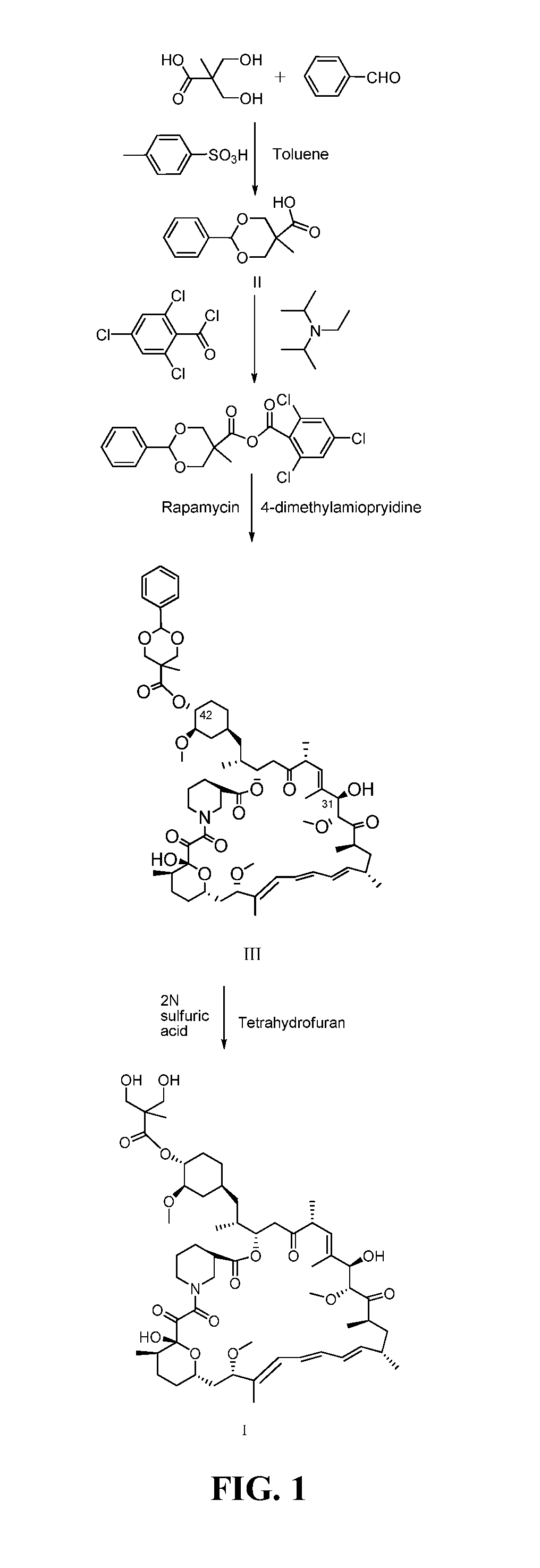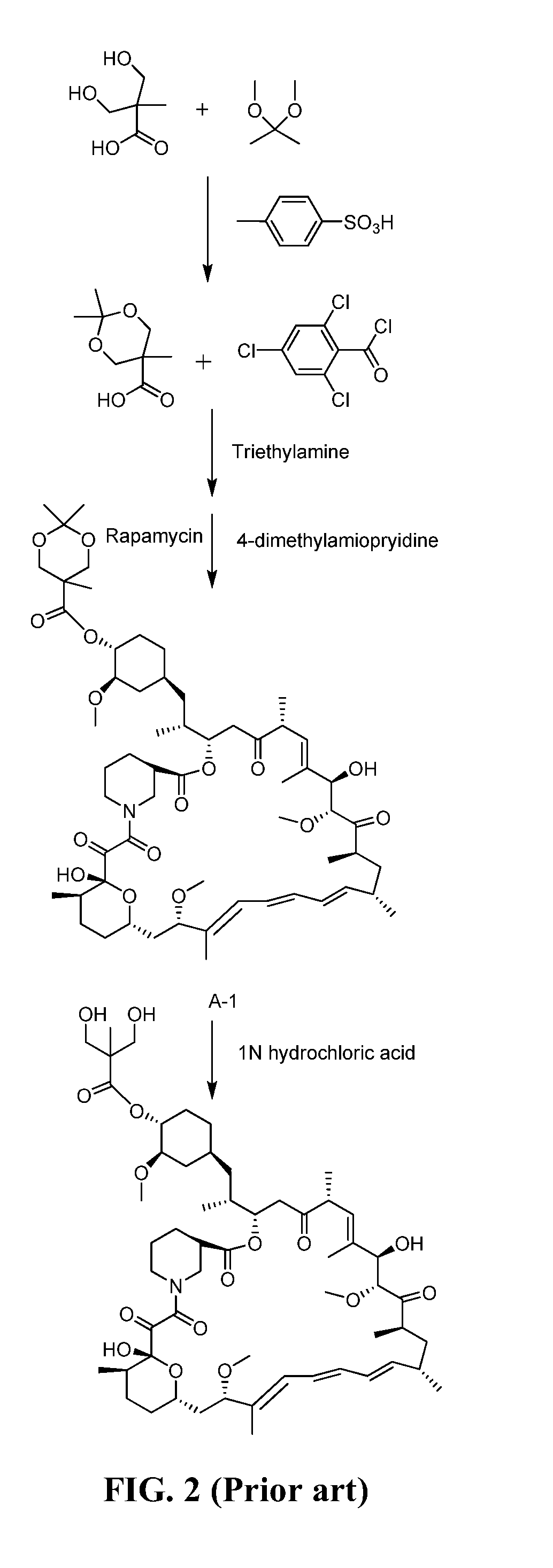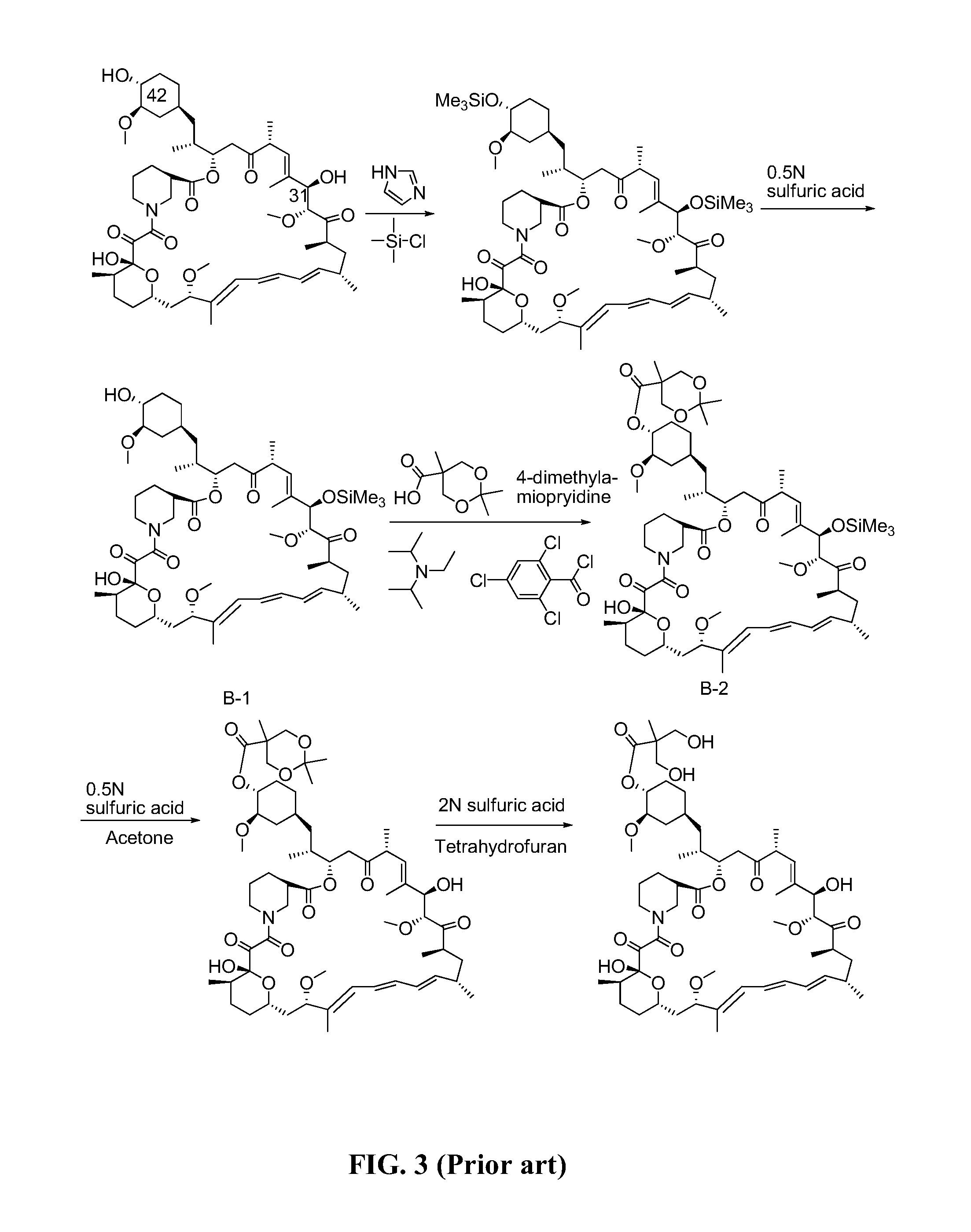Method for preparing temsirolimus
a technology of temsirolimus and temsirolimus, which is applied in the field of medical technology, can solve the problems of multiple reaction steps, complicated process, and difficulty in separating a product, and achieve the effects of low cost, simple process and high efficiency
- Summary
- Abstract
- Description
- Claims
- Application Information
AI Technical Summary
Benefits of technology
Problems solved by technology
Method used
Image
Examples
example 1
[0033]1) To a 100 mL single-mouth bottle 0.80 g (5.9 mmol) of 2,2-dimethylol propionic acid, 0.63 g (5.9 mmol) of benzaldehyde, 0.1 g of p-toluenesulfonic acid, and 40 mL of toluene were added to form a solution. The solution was then heated and refluxed for 8 h. Thereafter, the solution was cooled to room temperature and a product precipitated in a decompression condition. 30 mL of saturated sodium carbonate aqueous solution was added to the solution to from a mixture. After being stirred for 20 min, the mixture was transferred to a separating funnel, and was extracted by using 30 mL×3 of ether whereby separating an aqueous phase from an organic phase. A 2 N sulfuric acid was then added to the aqueous phase to neutralize the pH value thereof. Finally, the aqueous phase was filtrated and dried to a constant weight to yield intermediate II-1, the formula of which is as follows. 1.09 g of the intermediate II-1 was obtained, and the yield thereof was 82.3%.
[0034]
[0035]2) To a 100 mL fo...
example 2
[0038]1) To a 100 mL single-mouth bottle 0.80 g (5.9 mmol) of 2,2-dimethylol propionic acid, 0.83 g (5.9 mmol) of p-chlorobenzaldehyde, 0.13 g of p-toluenesulfonic acid, and 40 mL of toluene were added to form a solution. The solution was then heated and refluxed for 8 h. Thereafter, the solution was cooled to room temperature and a product precipitated in a decompression condition. 30 mL of saturated sodium carbonate aqueous solution was added to the solution to from a mixture. After being stirred for 20 min, the mixture was transferred to a separating funnel, and was extracted by using 30 mL×3 of ether whereby separating an aqueous phase from an organic phase. A 2 N sulfuric acid was then added to the aqueous phase to neutralize the pH value thereof. Finally, the aqueous phase was filtrated and dried to a constant weight to yield intermediate II-2, the formula of which is as follows. 1.28 g of the intermediate II-2 was obtained, and the yield thereof was 84.3%.
[0039]
[0040]2) To a ...
example 3
[0043]To a 100 mL four-mouth bottle 0.06 g (0.284 mmol) of the intermediate II-1 obtained from Example 1, 6 mL of dichloromethane, 0.04 g (0.438 mmol) of triethylamine, and 0.06 g (0.263 mmol) of 2,4,6-trichlorobenzoyl chloride were added to form a reaction solution. The reaction solution was stirred in the presence of nitrogen gas at the temperature of 14° C. for 4 h, and was then cooled to the temperature of −10° C. 0.02 g (0.219 mmol) of rapamycin and 0.05 g (0.438 mmol) of DMAP were added to the reaction solution. Thereafter, the reaction solution was heated to the temperature of 14° C. to react. After the reaction lasted for 14 h, 30 mL of water and 30 mL of ethyl acetate were added to the reaction solution and stirred for 10 min. A resulting mixture was then transferred to the separating funnel to separate an organic phase from an aqueous phase. After that, the organic phase was washed by using a 2N sulfuric solution (10 mL×2), water (10 mL), a 5% sodium bicarbonate aqueous so...
PUM
| Property | Measurement | Unit |
|---|---|---|
| temperature | aaaaa | aaaaa |
| temperature | aaaaa | aaaaa |
| temperature | aaaaa | aaaaa |
Abstract
Description
Claims
Application Information
 Login to View More
Login to View More - R&D
- Intellectual Property
- Life Sciences
- Materials
- Tech Scout
- Unparalleled Data Quality
- Higher Quality Content
- 60% Fewer Hallucinations
Browse by: Latest US Patents, China's latest patents, Technical Efficacy Thesaurus, Application Domain, Technology Topic, Popular Technical Reports.
© 2025 PatSnap. All rights reserved.Legal|Privacy policy|Modern Slavery Act Transparency Statement|Sitemap|About US| Contact US: help@patsnap.com



